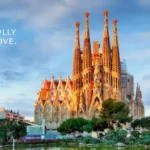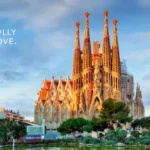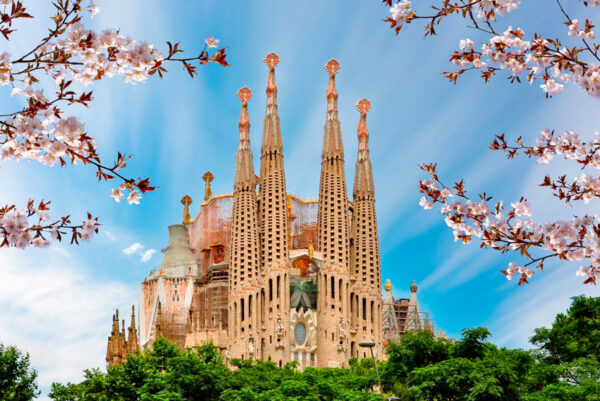
Barcelona's Sagrada Familia stands as a testament to architectural genius and artistic vision, captivating visitors from around the globe. The intricate details and towering spires of this iconic basilica not only reflect Antoni Gaudí's unique style but also tell the story of a city's rich cultural heritage.
In this article, we will delve into the awe-inspiring beauty of this landmark, showcasing its stunning features through mesmerizing visuals. Join us on this journey through **Captivating Images of Sagrada Familia: Exploring Barcelona's Iconic Landmark**, where each image reveals the breathtaking artistry and profound significance of Gaudí's masterpiece.
Captivating Details of Sagrada Familia's Architectural Design
The architectural design of Sagrada Familia is a harmonious blend of natural forms and religious symbolism. Gaudí drew inspiration from nature, incorporating organic shapes that mimic the structures of trees and flowers. This is most evident in the basilica's columns, which resemble tree trunks, creating a forest-like atmosphere within the nave. Visitors are often left in awe of how these elements contribute to the overall ethereal quality of the space.
One of the most captivating aspects of the Sagrada Familia is its intricate facade designs. The Nativity Facade, for instance, is adorned with numerous sculptures that depict scenes from the birth of Jesus, illustrating Gaudí's deep religious commitment. These details are not only aesthetically pleasing but also serve to convey profound spiritual messages. The facades are designed to tell stories, drawing visitors into a narrative that is both personal and universal.
Gaudí's use of color and light further enhances the basilica's enchanting atmosphere. The stained glass windows are crafted to filter sunlight into a vibrant spectrum, creating a dynamic play of colors that shifts throughout the day. The light effects serve to elevate the spiritual experience, filling the interior with a sense of transcendent beauty. This clever manipulation of light illustrates Gaudí’s understanding of how architecture can influence human emotions.
Below is a comparison of the three main facades, highlighting their distinct characteristics:
| Facade | Theme | Key Features |
|---|---|---|
| Nativity Facade | Birth of Jesus | Detailed sculptures, organic motifs |
| Passion Facade | Crucifixion | Angular forms, stark simplicity |
| Glory Facade | Resurrection | Grand scale, dynamic composition |
The Symbolism Behind Sagrada Familia's Intricate Facades
The Sagrada Familia's facades are rich in symbolism, each meticulously designed to reflect key aspects of the Christian faith. The Nativity Facade reminds viewers of the joy and innocence of Jesus' birth, filled with playful figures and intricate details that invite contemplation and celebration. In contrast, the Passion Facade conveys a sense of somberness and sacrifice, using stark angular lines and minimal ornamentation to evoke the gravity of the Crucifixion.
Each facade serves to tell its unique story, using architectural elements to represent important themes in Christianity. For instance, the Glory Facade symbolizes the resurrection and eternal life, portrayed through soaring towers and dynamic sculptures that reach towards the heavens. This facade not only captures the essence of hope but also represents the culmination of Gaudí's vision for the basilica.
Furthermore, the facades are infused with natural symbolism, embodying a connection to the environment. Gaudí often used organic shapes and patterns to mirror the beauty of nature, which can be seen in the floral motifs and tree-like structures throughout the facades. This integration of nature into religious architecture creates a profound dialogue between faith and the natural world, enriching the spiritual experience for visitors.
Visitors can appreciate the intricate details through a closer examination of the different facades, which highlight the relationship between architecture and nature. Here are some key symbolic elements found in each facade:
- Nativity Facade: Represents joy and birth with playful sculptures of animals and biblical figures.
- Passion Facade: Conveys suffering and sacrifice through its harsh lines and minimalistic style.
- Glory Facade: Symbolizes resurrection and hope with grand structures that rise dramatically into the sky.
Discovering the History of Barcelona's Sagrada Familia
The Sagrada Familia's construction began in 1882, under the initial guidance of architect Francisco de Paula del Villar. However, it wasn't until Antoni Gaudí took over in 1883 that the project transformed into a visionary masterpiece. Gaudí's innovative approach incorporated intricate details and a distinct style, setting the foundation for a landmark that reflects both his genius and the spiritual aspirations of the city.
As the Sagrada Familia evolved, it became a symbol of Barcelona's cultural identity. With its unique blend of Gothic and Art Nouveau styles, the basilica has drawn attention not only for its architectural ingenuity but also for the rich history it represents. Significant milestones in its construction include the unveiling of the Nativity Facade in 1930 and the ongoing work on the Glory Facade, which showcases the ambitious vision that continues to inspire artisans and architects.
Throughout its history, the Sagrada Familia has also faced numerous challenges, including interruptions due to the Spanish Civil War and funding limitations. Despite these obstacles, the project has persevered, thanks largely to the dedication of craftsmen and the unwavering support of the community. Today, it stands as a monumental testament to the collaborative effort of generations striving to see Gaudí's dream realized.
Key events in the history of the Sagrada Familia include:
- 1882: Groundbreaking and initial design by Francisco de Paula del Villar.
- 1883: Antoni Gaudí takes over, transforming the original plans.
- 1930: Completion of the Nativity Facade, marking a significant milestone.
- 2026: Anticipated completion of the basilica, coinciding with the centenary of Gaudí's death.
Top Tips for Capturing Stunning Photos of Sagrada Familia
When capturing stunning photos of the Sagrada Familia, the time of day can dramatically affect your shots. Golden hours, which occur shortly after sunrise and just before sunset, offer soft lighting that enhances the intricate details of the basilica's facades. During these times, the warm tones of the sun bring out the vibrant colors of the stained glass and the sculptural elements, creating a magical atmosphere perfect for photography.
Another essential tip is to experiment with different angles and perspectives. While the classic frontal view is iconic, exploring side angles or capturing the basilica from a distance can yield unique compositions. Try framing the Sagrada Familia with surrounding trees or buildings for a more dynamic photo. Additionally, consider using a wide-angle lens to capture the magnificent scale of this architectural wonder.
Don’t forget to pay attention to the details! The Sagrada Familia is adorned with countless intricate sculptures and carvings that tell stories of faith and nature. Zoom in on these features to capture their beauty. Using a tripod can help achieve stability, especially in low-light conditions, allowing you to take longer exposures without sacrificing image quality.
Lastly, be patient and wait for the right moment. Visitors constantly move around the site, so timing your shots for when the area is less crowded can help you achieve clean photos. Consider visiting during weekdays or off-peak hours to enhance your chances of capturing the Sagrada Familia in its full glory, allowing the basilica's stunning architecture to shine through without distractions.
Why Sagrada Familia is a Must-See Landmark in Barcelona
The Sagrada Familia is a must-see landmark in Barcelona not only for its architectural brilliance but also for its profound cultural significance. As a UNESCO World Heritage Site, it showcases the innovative genius of Antoni Gaudí, whose vision transformed the basilica into a symbol of the city. The intricate designs and towering spires are not merely for aesthetics; they embody the spiritual aspirations and artistic heritage of Barcelona, making it a focal point for both locals and tourists alike.
Another compelling reason to visit the Sagrada Familia is its ongoing construction, which adds an element of dynamism to this already remarkable site. Since its inception in 1882, the basilica has continually evolved, reflecting changes in architectural techniques and artistic trends. This continuous development is a testament to Gaudí's lasting influence and the collaborative efforts of craftsmen dedicated to realizing his vision, inviting visitors to witness history in the making.
The interior of the Sagrada Familia is equally captivating, characterized by a unique interplay of light and color. The stained glass windows, designed to create a kaleidoscope of hues, transform the ambiance as sunlight filters through, enhancing the experience of spirituality within the space. Each visit offers something new, as different times of day yield varying light effects, making it a place that encourages multiple explorations and deeper understanding of Gaudí's artistic intentions.
Lastly, the Sagrada Familia serves as a bridge connecting Barcelona’s past, present, and future. It embodies the city’s cultural identity while inspiring generations of architects and artists worldwide. By visiting this landmark, you engage with a unique blend of history, art, and spirituality, making it an essential stop for anyone seeking to understand the heart and soul of Barcelona.
Exploring the Artistic Elements of Gaudí's Masterpiece
Exploring the artistic elements of Gaudí's masterpiece, the Sagrada Familia, reveals a tapestry of creativity that transcends traditional architectural boundaries. The use of geometric shapes and organic forms reflects Gaudí's deep connection with nature. This integration allows the structure to resonate with both the spiritual and the earthly, creating an immersive experience for all who visit.
One of the most significant artistic features is Gaudí's innovative approach to light and shadow. The interplay of natural light filtering through the stained glass windows not only enhances the visual aesthetics but also creates an emotional atmosphere within the basilica. This thoughtful design fosters a sense of serenity and contemplation, inviting visitors to engage with the spirituality of the space.
Additionally, Gaudí's application of symbolism is deeply woven into the fabric of the Sagrada Familia. Each architectural element serves a purpose, from the towering spires that reach towards the heavens to the intricate carvings that depict biblical narratives. These artistic choices play a vital role in conveying the underlying themes of faith and hope, allowing the building to tell its own story.
Here are some of the key artistic elements that define Gaudí's vision:
- Natural Forms: Columns resembling tree trunks create a forest-like atmosphere.
- Colorful Stained Glass: Vivid hues transform light into a dynamic experience.
- Symbolic Sculptures: Each facade features sculptures that narrate religious stories.
- Geometric Patterns: Complex shapes reflect Gaudí's fascination with mathematics and nature.
 Exploring the Majestic Sagrada Familia: A Captivating Barcelona Tour
Exploring the Majestic Sagrada Familia: A Captivating Barcelona Tour The Majestic Barcelona Towers: Exploring the Magic of Sagrada Familia
The Majestic Barcelona Towers: Exploring the Magic of Sagrada FamiliaIf you want to know other articles similar to Captivating Images of Sagrada Familia: Exploring Barcelona's Iconic Landmark you can visit the category WHERE YOU CAN GO.
Leave a Reply










Read more!